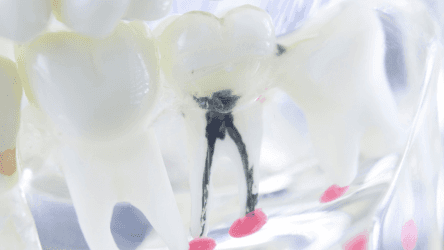
It's not uncommon for a tooth to darken after a root canal. While root canal therapy in Royal Palm Beach can save a severely damaged or infected tooth, it can also leave that tooth looking noticeably darker than the rest. For many patients, this comes as a surprise, especially after the pain is gone and the tooth is restored.
So, what causes this color change? And more importantly, what are your options to fix it?
Why Does the Tooth Turn Dark in the First Place?
When a tooth undergoes root canal therapy, the nerve, blood supply, and pulp tissue inside are removed. Although this eliminates the infection and relieves pain, it also means the tooth is no longer living. Without a blood supply, the tooth becomes dehydrated over time, which can give it a dull, grey appearance.
Discoloration can also happen if remnants of the pulp tissue are left behind. In some cases, materials used to seal the tooth may show through thin enamel. Trauma to the tooth, which often precedes a root canal, can also cause internal bleeding that stains the inside.
How Soon After Root Canal Therapy Does the Tooth Darken?
It varies. Some teeth start to change color within a few weeks. Others take months or even years. Front teeth tend to show the most visible changes, especially if the enamel is already thin or translucent. If you've had root canal therapy in Royal Palm Beach and notice your tooth getting darker, it's worth discussing cosmetic options sooner rather than later.
Can You Prevent the Tooth from Darkening?
Prevention is possible in some cases. Some dentists now place internal bleaching agents or use tooth-colored materials during the restoration phase to reduce the risk of visible discoloration. A well-sealed and properly restored tooth is less likely to stain internally.
However, once the tissue is removed and the tooth loses its vitality, some color change is likely over time. The extent depends on how the root canal was performed, the materials used, and the condition of the tooth beforehand.
What Can Be Done to Fix a Dark Root Canal Tooth?
Several treatment options exist, depending on how noticeable the discoloration is and where the tooth sits in your smile line.
- Internal bleaching: This is often the first step. A dentist removes the filling material inside the tooth and places a whitening agent. The process may be repeated until the desired shade is reached, then sealed again.
- External bleaching: Less effective for root canal-treated teeth but can help in mild cases or for surrounding teeth.
- Composite bonding: A tooth-colored resin is applied and shaped over the surface to mask the darkness.
- Porcelain veneers: Thin shells of porcelain are bonded to the front of the tooth. They offer a more durable and stain-resistant solution.
- Crowns: In cases of severe discoloration or structural weakness, a full crown may be the best choice. Modern ceramic crowns can match surrounding teeth almost perfectly.
If you're unsure which option suits your case, consult a dentist who provides cosmetic and restorative care alongside root canal therapy in Royal Palm Beach.
Is the Darkening a Sign of Treatment Failure?
No—not usually. A dark tooth doesn’t mean the root canal failed. As long as there are no signs of infection, pain, or swelling, the tooth is likely still healthy. Discolouration is cosmetic, not functional. However, it can affect your confidence, especially when it’s a front tooth.
If you notice new discoloration combined with pain, sensitivity, or swelling, that’s a different story. It might mean the treatment needs to be reviewed or redone.
Should You Worry About It?
From a health standpoint, a dark tooth post-root canal isn't an urgent problem. But from a personal and social perspective, it can matter. A dark front tooth can make people self-conscious about smiling, especially in photos or public settings.
Many people who’ve had root canal therapy in Royal Palm Beach opt for cosmetic treatment not out of necessity, but because they want their smile to look whole again.
Don’t Settle for a Darkened Tooth
Root canal therapy in Royal Palm Beach saves teeth, but it can leave behind cosmetic issues like discoloration. The good news is that modern dentistry offers several effective solutions—from internal bleaching to full crowns—to bring the treated tooth back in line with the rest of your smile.
If you've had a root canal and notice your tooth turning dark, speak with your dentist about cosmetic options that can restore its appearance. With the right approach, you don't have to live with a smile that feels incomplete.

